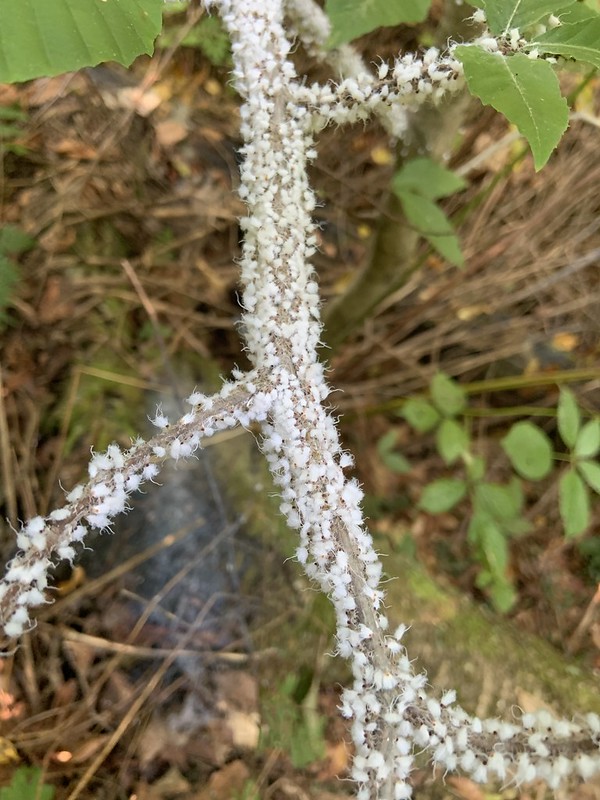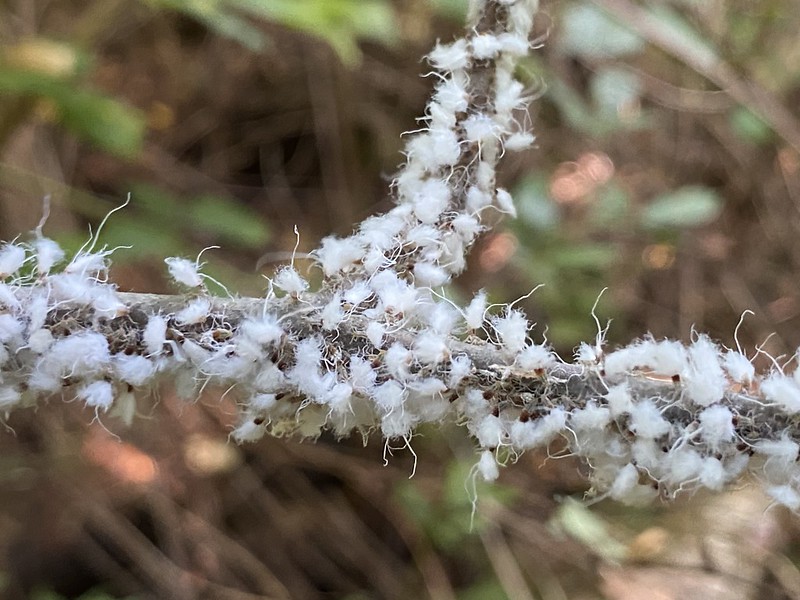By Emma Roth, Nature Educator and Animal Care Specialist
A couple of weekends ago, I found myself wandering down a trail, with a backpack full of camping gear. Backpacking, while not something I do as often as I would like, is one of my favorite hobbies. There’s something so satisfying about knowing you have everything you need to survive on your back, and a cozy campsite to look forward to for the night.
Backpacking can easily be split into two components: hiking and camping. While I’d love to say I enjoy both parts equally, I often find myself impatient while hiking, itching to get to camp, set up my tent, make a fire, and watch darkness take over the forest.
But there are those special moments while hiking that make me pause, take a second, and enjoy the natural wonders I am walking past. On this hike, my attention was grabbed by a couple of small white, fluffy specks on the ground. As we approached, the specks started to dance.
On a rock, were about a dozen little white balls of fluff. Each one was only a few millimeters wide. From a few feet away, they looked like little bits of lint or clumps of dust. What caught our attention was their brilliant white color and their wiggling dance moves. They were clearly alive.

As we bent down to inspect then, we realized what they were: aphids. Tiny insects that feed by sucking the sap from plants. They are the foe of many gardeners and come in all shapes and colors. Finding aphids on a rock, like we found on the trail, is not normal, making their appearance even more interesting.
But the aphid surprises were not over. As I crouched down, looking at this rock, I felt the slightest drizzle. Just a few drops occasionally hitting my arm or hand. This was odd since it was a beautiful clear day. As I looked up, the source was quickly obvious. A large beech tree spread its branches over the trail and the branches were absolutely coated with the wooly white aphids. So much so, the bark was barely visible. What I was feeling was not a spurt of rain, but drops of honeydew, or in other words, aphid poop.
The aphids we found were Beech Blight Aphids. These aphids thrive on the sap of American Beech trees. While they drink the tree’s sap, infestations rarely cause the trees to die. Bad infestations may cause the loss of twigs or small branches, but the overall health of the tree is not in danger.
One of the most distinctive features of this type of aphid, besides their shocking white color and fluffy appearance, is their impressive dance moves, which have rightly earned them the nickname “boogie-woogie aphids”. When threatened, the aphids will raise their abdomens, the fluffy white rear section of their bodies, and wiggle them in the air. When hundreds or thousands of aphids do this close together, it is quite a sight and can help distract potential predators and prevent them from seeing the individual insects, making the aphids far less appetizing.
When I’m hiking towards a campsite, it’s often these small, little things that grab my attention and take me back to the moment, instead of daydreaming about the campsite ahead. Where I go hiking, I’m often in denser forests, with minimal views or sweeping vistas. As I hike, I’m focused on the ground to keep from tripping and taking a tumble with a heavy pack. I think this is when the little nature treasures shine. They distract me from burning muscles, sore feet, and allow me to take a break.
We spent about 10 minutes admiring these little aphids. We even shared the moment with another hiker who happened to be passing by, equally enthralled by the wiggly white puffs. And when we moved on, I felt re-energized. Not just from the physical break in the hike, but by a renewed enthusiasm to notice the surprises that are around me.
Audubon Community Nature Center builds and nurtures connections between people and nature. ACNC is located just east of Route 62 between Warren and Jamestown. The trails and outdoor facilities are open from dawn to dusk. The Nature Center is open from 10 a.m. until 4:30 p.m. daily except Sunday when it opens at 1 p.m. More information can be found online at auduboncnc.org or by calling (716) 569-2345.


Recent Comments